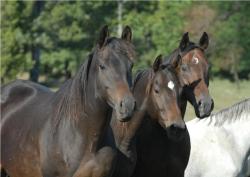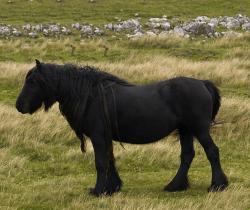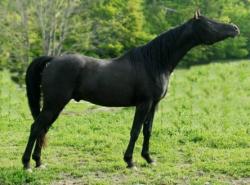Pictorial Guide to Horse Colors Part 1

A colorful horse herd image by Eduardo Amorim
Chestnut
A chestnut is a red(ish) horse with no black pigment. Chestnuts vary greatly, from pale with a light mane and tail (flaxen), to a deep burgundy that can be mistaken for black. Although there is great variation in this color, most chestnut horses will fall into the middle of this color spectrum and are easy to recognize. A chestnut will never have black legs or a black mane and tail. They can however have a mane and tail that is darker than their body even to the point of being “almost” black.

A "Liver" Chestnut" This is a dark shade of chestnut. In Quarter Horses it is often called just Chestnut
Bay
A bay is a red(ish) horse with a Black mane and tail and also black lower legs. They also have black "ear tips" meaning that the very tips of the ears will be black. The black areas of a bay horse are referred to a "points". The bay horse's body will be the same color as the chestnuts above and can vary to the same degree. Although the body color and amount of black will vary from horse to horse, at least some of the lower leg (pasterns) and mane and tail will be black in a bay. Bay horses with very low leg black are sometimes referred to a "wild-bay" however, young bay horses will often have lower black points and should not be considered "wild-bay" until they are mature. Usually by the age of four a horse will have developed their full points although some may continue to develop darker points later in life.
A bay whose leg black is lowered to the level of the pasterns is known as a "Wild-Bay" notice the mane and tail are still black
Brown
A brown horse is very similar to a bay horse except that they will have more black coloration on their bodies. They may have higher leg black and also have black scattered along the top-line almost like a shadow had been laid over them. They often have a darker body coat as well and their coat color can vary tremendous by season. If you have a horse that you think is black one season and bay the next you almost certainly have a "brown". Brown horses usually have lighter areas at the muzzle, flanks, and "arm pits". It is not uncommon for a brown horse that is very dark to be mistaken for a black with a light muzzle. Brown horses foals often exhibit dorsal stripes and shoulder bars when they are born. This is called "countershading" and is not related to dun.

Although this horse does not have a typical brown muzzle it is lighter in the flank and has the classic "shadow" over the topline
Black
A black horse is ideally solid black with no brown hair. Blacks can fade however and in some blacks this can result in a reddish tinge to the mane, end of the tail or coat. In some horses fading can be reversed by feeding minerals but some black horses will fade even when all nutritional needs are met. It is not known at this time why such fading occurs.

A black Arabian mare with sun fading. This fading can be difficult to distinguish from dark brown but generally faded blacks are more consistent in color throughout the year and lack lighter areas at the muzzle and flanks that are typical of brown.
If you would like to know more about horse coat color and how it is inherited visit Beginning Horse Coat Color Genetics





